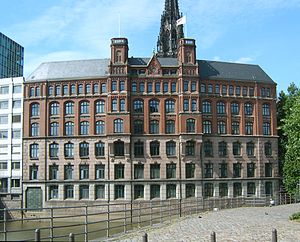F. Laeisz
| Company type | partnership |
|---|---|
| Industry | shipping, trade, insurance |
| Founded | Hamburg, Germany (March 24, 1824) |
| Founder | Ferdinand Laeisz |
| Headquarters | Hamburg , Germany |
Number of locations | 4 locations (Hamburg, Rostock, Bremerhaven and Grabow) |
| Owner | Nikolaus W. Schües, Nikolaus H. Schües (CEO) |
Number of employees | 1,250 |
| Website | http://www.laeisz.de |
F. Laeisz (pronounce lyze; short FL), is an old established and today still active shipping company (present offices in Hamburg, Rostock, Bremerhaven and Grabow, Germany, as well as Japan and Philippines)
History of the shipping company
The firm was established by Ferdinand Laeisz on 24 March 1824 as a production company for tall hats. Expansion to overseas markets enabled him to purchase in 1839 the brig “Carl”, named after his son, who joined the firm as partner on 1 March 1852. 1857 the first new building was commissioned, a wooden barque named “Pudel” after Carl’s wife Sophie Laeisz. Sophie’s nickname followed her hairstyle.[1]

All following own new buildings after 1861 were christened with names starting with a “P”. This is the reason why British seamen called the company “P-Line”. Carl Laeisz credo was “My ships can and must perform fast voyages.” and this stood for reliability and speed of his tall ships, consequently they became famous as “Flying P-Liner”.
1892 F. Laeisz purchased its first iron steamship (Hamburg, renamed Naxos) from the Hamburg-Südamerikanischen Dampfschifffahrts-Gesellschaft (co-founded by Laeisz 1871) which was employed by Deutsche Levante Linie (DLL, co-founded by Laeisz 1889). By and by a market position developed through establishing further steamship lines (like 1847 co-founder Hapag, 1874 co-founder Deutsch-Australische Dampfschifffahrtsgesellschaft, 1886 co-founder Woermann-Linie, 1890 co-founder Deutsch-Ost-Afrika-Linie)
The companies which were co-founded were progressively trading with steamships, while Laeisz continued the tall ship tradition which generated fame and profit with the nitrate trade from Chile. Until the end of the nineteen twenties Laeisz kept its engagement in the Chile trade with nitrate until it became possible to produce nitrate by the Haber-Bosch-System and the Chile trade came to an end.
1897/98 the Laeiszhof was built at Trostbrücke 1 in Hamburg, a landmark building, which is until today the head office of the company.

1914 the first banana reefer ships “Pioneer” and “Pungo” were ordered for the Afrikanische Frucht-Companie established 1912 by F. Laeisz. The outbreak of World War Ⅰ made it impossible for the company to commission these two ships for employment in its own banana trade. With “Poseidon” Laeisz commissioned 1923 its first Steamer for its own liner service to the SAWC and 1926 the last four-masted barque Padua was built for FL. This newbuilding signaled the end of the Flying P-Liner area which terminated with the end of World War II when “Padua” was given to the USSR, still trading as “Krusenstern” to this day.
The company owns since 1904 shares of the Brazilian BRAHMA, forerunner of today’s brewery AMBEV. The shares were confiscated by the Brazilian government 1942 as security for war damages. The release from the blockage the government still delays.[2]
After Mr Paul Ganssauge (1924), Mr Willi Ganssauge (1936) and Mr Nikolaus W. Schües (1973) and their families became partners of the Laeisz family, in 1982 the newly established F. Laeisz Schiffahrtsgesellschaft mbH + Co. took over all shipping activities owing to a severe shipping crisis. Owners of the new company are Schües and – for a few years - F. Laeisz.[3]
2004 Schües purchased the 1824 founded partnership F. Laeisz with all legal rights of its history. Reederei F. Laeisz, Rostock, is today the operating company, F. Laeisz GmbH, Hamburg, functions as holding company.

Today the company operates container ships, bulk carriers, gas- and car carriers as well as research vessels for the German government (AWI). Almost all ships are named with the P-names. MV “Peene Ore” the company’s flagship, is the largest vessel flying the German flag.[4]
January 2005 the Musikhalle Hamburg is again called “Laeiszhalle”. Carl Laeisz had instructed the company in his will to pay 1.2 Million Mark for the construction of a music hall, his widow Sophie increased the amount in 1907 by 40% to finish the building. When in 1908 the building was opened it was the largest and most modern concert hall in Germany and was known as Laeiszhalle until 1933.[5]
See also

- Flying P-Liner with a list of all tall ships operated by F. Laeisz
- Deutsche Segelschiff-Kontor GmbH, a joint venture company after the first world war to share reparation payments, with F. Laeisz participation.
References
- ^ z. B.Sophie Laeisz. Hamburger Abendblatt. (abgerufen am 3. März 2008)
- ^ http://www.nzz.ch/wirtschaft/unternehmen/ein-schatz-in-uebersee-1.18209614
- ^ Das Unternehmen. Der Neuaufbau. „Von 1982 bis 1989“. auf den Internetseiten von F. Laeisz (abgerufen am 3. März 2008)
- ^ Peer Schmidt-Walther: Riesenfrachter im Orkan. In: Ders., Frachtschiffreisen. Als Passagier an Bord. Koehlers Verlagsgesellschaft, 2. überarbeitete Auflage, Hamburg 2010, S. 153–155, ISBN 978-3-7822-1016-4.
- ^ Sophie Laeisz. Hamburger Abendblatt. (abgerufen am 3. März 2008)
Literature
- Peter Klingbeil: Die Flying P-Liner. Die Segelschiffe der Reederei F. Laeisz. Verlag „Die Hanse“, Hamburg 1998 u. 2000, ISBN 3-434-52562-9.
- Hans Georg Prager: „F. Laeisz“ vom Frachtsegler bis zum Bulk Carrier. Koehlers Verlagsgesellschaft mbH, Herford 1974, ISBN 3-7822-0096-9.
